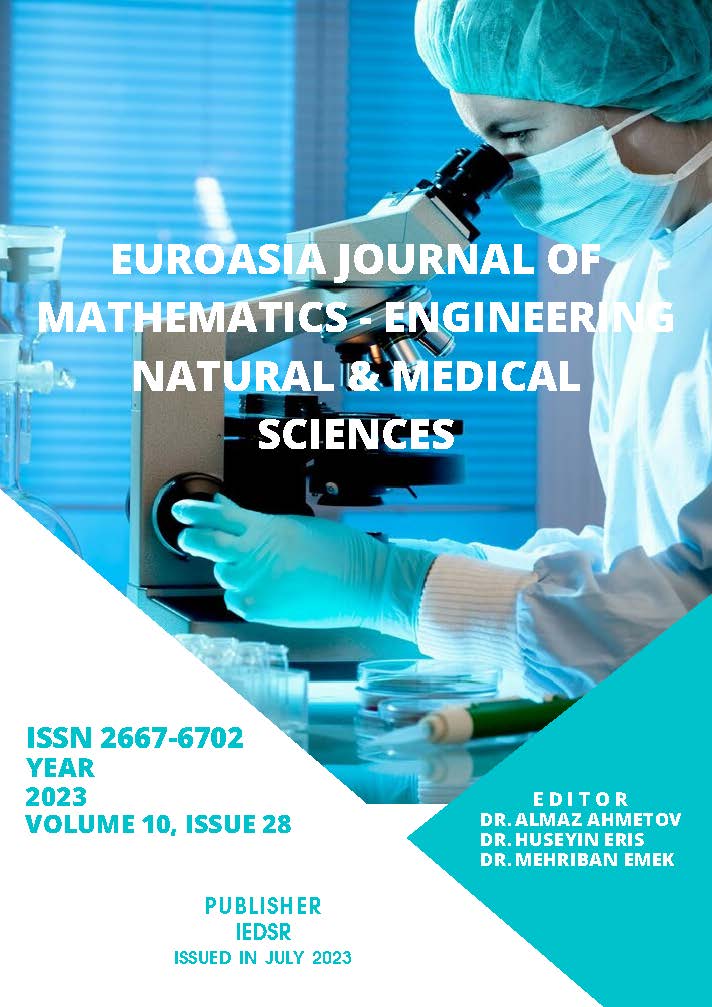Ordinal Verilerde İki Değerlendirici Arasındaki Uyum İstatistiklerinin Örneklem Büyüklüğünden ve Kategori Sayısından Etkilenme Durumları
DOI:
https://doi.org/10.5281/zenodo.8239340Anahtar Kelimeler:
Brennan-Prediger, Gwet's AC2, Krippendorff's Alpha, Lineer ağırlıklı, Karesel ağırlıklı, Spearman korelasyon katsayısıÖzet
Bu çalışmada amaç, sıralı ölçeklerde kullanılan değerlendiriciler arası ağırlıklandırılmış uyum istatistiklerini tanıtmak, sıralı ölçekler için kullanılan Spearman korelasyon katsayısı ile ağırlıklandırılmış uyum istatistiklerini karşılaştırmak ve örneklem büyüklüğünden, kategori sayısından etkilenme durumlarını ortaya koymaktır. Cohen’s k, Scott's π, Brennan-Prediger’s (B-P), Gwet's AC2 and Krippendorff's Alpha are some of the common chance-corrected agreement measures to assess the agreement among two raters for ordinal outcome. The Pearson correlation, Spearman correlation and ICC are widely used for assessing reliability when ratings are on an interval scale. Both weighted agreement coefficients and correlation coefficients can be used to assess the reliability of ordinal rating scales. Bu amaçla, iki değerlendirici arasında ilişki yok iken, düşük, orta ve yüksek ilişki var iken farklı örneklem büyüklükleri ve kategori sayıları için veriler üretilmiş ve sözü edilen ağırlıklandırılmış uyum istatistikleri hesaplatılmıştır. Cohen’s kappa, Scott’s π ve Krippendorff Alpha katsayılarının korelasyon katsayıları ile benzer sonuçlar verdiği, B-P uyum istatistiğinde korelasyon katsayısı değerine çok yakın değerler aldığı söylenebilir. Ancak, Gwet’s AC2 istatistiği, özellikle kategori sayısı 3 için, değerlendiriciler arasında ilişkinin olmadığı/düşük bir ilişkinin söz konusu olduğu durumlarda, korelasyon katsayısı değerinden farklılık gösterdiği ve değerlendiriciler arasında şansa bağlı da olsa orta düzeyde bir uyumdan bahsedilebileceği söylenebilir. Sıralı ölçeklerde iki değerlendirici arasındaki uyum araştırılırken, sadece kategori sayısı 3 olduğu durumlarda dikkat edilmesi ve uyum istatistiği olarak Gwet’s AC2 uyum istatistiğinin kullanılması tavsiye edilmektedir. Bunun dışındaki diğer durumlarda, uyum ile ilişki kavramının birbirinin yerine gönül rahatlığı ile kullanılabileceği söylenebilir.
Referanslar
Barnhart H.X., Haber M.J. & Lin L.I. (2007). An overview on assessing agreement with continuous measurements. Journal of Biopharmaceutical Statistics 17(4):529-569. DOI: https:// doi.org/10.1080/10543400701376480.
Bland J.M. & Altman D.G. (2010). Statistical methods for assessing agreement between two methods of clinical measurement. International Journal of Nursing Studies 47(8):931-936.DOI: https://doi.org/10.1016/j.ijnurstu.2009.10.001.
Brennan R.L. & Prediger D.J. (1981). Coefficient kappa: Some uses, misuses, and alternatives. Educational and Psychological Measurement 41(3):687-699. DOI: https://doi.org/10.1177/001316448104100307.
Cicchetti D. & Allison T. (1971). A new procedure for assessing reliability of scoring EEG sleep recordings. The American Journal of EEG Technology 11(3):101-109. DOI: https://doi.org/10.1080/00029238.1971.11080840.
Cohen J. (1968). Weighted kappa: Nominal scale agreement provision for scaled disagreement or partial credit. Psychological Bulletin 70(4):213-220. DOI: https://doi.org/10.1037/h0026256.
Fleiss J.L. & Cohen J. (1973). The equivalence of weighted kappa and the intraclass correlation coefficient as measures of reliability. Educational and Psychological Measurement 33(3):613–619. DOI: https://doi.org/10.1177/001316447303300309
Gwet K.L. (2014). Handbook of inter-rater reliability: The definitive guide to measuring the extent of agreement among raters. 4 th edition, pp. 27-127, 185-302. Advanced Analytic, LLC, Gaithersburg, USA.
Gwet K.L. (2015.) Testing the difference of correlated agreement coefficients for statistical significance. Educational and Psychological Measurement 76(4):609-637. DOI: 10.1177/0013164415596420.
Haber M. & Barnhart H.X. (2008). A general approach to evaluating agreement between two observers or methods of measurement. Statistical Methods in Medical Research 17(2):151-169. DOI: 10.1177/0962280206075527.
Haber M., Barnhart H.X., Song J. & Gruden J (2005). Observer variability: A new approach in evaluating interobserver agreement. Journal of Data Science 3(1):69-83.
Kanık E.A., Erdogan S. & Temel G.O. (2012). Agreement statistics impacts of prevalence between the two clinicians in binary diagnostic tests. Annals of Medical Research 19(3):153-158. DOI: 10.7247/jiumf.19.3.5.
Kanık E.A., Orekici Temel G. & Ersöz Kaya I. (2010). Effect of sample size, the number of raters and the category levels of diagnostic test on Krippendorff alpha and the Fleiss kappa statistics for calculating inter rater agreement: A simulation study. Türkiye Klinikleri Journal of Biostatistics 2(2):74-81. DOI:10.7247/jtomc.19.4.4.
Krippendorff K. (2004). Measuring the reliability of qualitative text analysis data. Quality and Quantity 38(6):787-800. DOI: http://dx.doi.org/10.1007/s11135-004-8107-7.
Lin L. (2008). Overview of agreement statistics for medical devices. Journal of Biopharmaceutical Statistics 18(1):126-144. DOI: 10.1080/10543400701668290.
Lin L., Hedayat A.S. & Wu W. (2007). A Unified approach for assessing agreement for continuous and categorical data. Journal of Biopharmaceutical Statistics 17(4):629-652.
Lin L., Hedayet A.S. & Wu W. (2012). Statistical tools for measuring agreement. 1st edition, pp. 1-109. Springer, New York.
Liu J., Tang W., Chen G., Lu Y., Feng C. & Tu X.M. (2016). Correlation and agreement: overview and clarification of competing concepts and measures. Shanghai Archives of Psychiatry 28(2):115-120. DOI: 10.11919/j.issn.1002-0829.216045.
Moradzadeh N., Ganjali M. & Baghfalaki T. (2017). Weighted Kappa as a function of unweighted kappas. Communications in Statistics-Simulation and Computation 46(5):3769-3780. DOI:10.1080/03610918.2015.1105975
Nelson K.P. & Edwards D. (2018). A measure of association for ordered categorical data in population-based studies. Statistical Methods in Medical Research 27(3):812-831. DOI: 10.1177/0962280216643347.
Raadt A., Warrens M., Bosker R. & Kiers H.A.L. (2021). A comparison of reliability coefficient for ordinal rating scales. Journal of Classification:1-25. DOI: https://doi.org/10.1007/s00357-021-09386-5.
Stralen K.J., Dekker F.W., Zoccali C. & Jager K.J. (2012). Measuring agreement, more complicated than it seems. Nephron Clinical Practice 120(3):c162-c167. DOI: 10.1159/000337798.
Tran D., Dolgun A. & Demirhan H. (2020.) Weighted inter-rater agreement measures for ordinal outcomes. Communications in Statistics-Simulation and Computation 49(4):989-1003. DOI: https://doi.org/10.1080/03610918.2018.1490428.
Tran Q.D., Dolgun A. & Demirhan H. (2021). The impact of gray zones on the accuracy of agreement measures for ordinal tables. BMC Medical Research Methodology 21(1):1-9. DOI:10.1186/s12874-021-01248-3.
Vanbella S. (2016). A new interpretation of the weighted kappa coefficients. Psychometrika 81(2):399-410. DOI: 10.1007/s11336-014-9439-4.
Vanbelle S. & Albert A. (2009). A note on the linearly weighted kappa coefficient for ordinal scales. Statistical Methodology 6(2):157-163. DOI: https://doi.org/10.1016/j.stamet.2008.06.001.
Warrens M.J. (2012). Some paradoxical results for the quadratically weighted kappa. Psychometrika 77(2):315-323. DOI: 10.1007/S11336-012-9258-4.
İndir
Yayınlanmış
Nasıl Atıf Yapılır
Sayı
Bölüm
Lisans
Telif Hakkı (c) 2023 Euroasia Journal of Mathematics, Engineering, Natural & Medical Sciences

Bu çalışma Creative Commons Attribution-NonCommercial 4.0 International License ile lisanslanmıştır.

